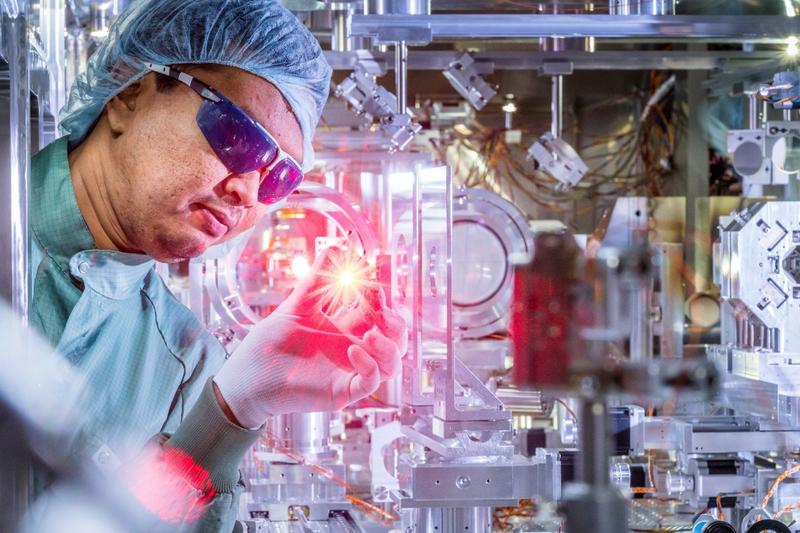Saxony Bundles Expertise in the Field of Nuclear Fusion
EU and Free State Provide €2.4 Million in Funding for SAXFUSION Network
With SAXFUSION, Saxony launches its first state-wide competence network for future technologies in nuclear fusion. The aim is to advance fusion as a clean, safe, and base-load capable energy source, to build strategic expertise, and to make the results available to industry and society. The Helmholtz-Zentrum Dresden-Rossendorf (HZDR) coordinates the project. The Fraunhofer Institute for Material and Beam Technology IWS co-leads the project. Other renowned Saxon research institutions participate as well. In addition, SAXFUSION integrates major international projects and industrial partners through cooperation agreements. The European Union and the Free State of Saxony support the project with around €2.4 million euros from the Just Transition Fund.
Controlled fusion of atomic nuclei offers the long-term possibility of ensuring a sustainable, emission-free energy supply. Various approaches are available for this purpose, most of which aim to generate and control a so-called plasma in which electrons and atomic nuclei can move freely and independently of one another—just like inside our sun. Leading international institutions such as ITER in southern France, Lawrence Livermore National Laboratory (LLNL) in the USA, and Wendelstein-7X in Germany have already achieved significant technological advances. Nevertheless, numerous questions remain unanswered, for example regarding the long-term stability of materials exposed to plasma, or for the efficient control of the fusion process. This is precisely where SAXFUSION takes action.
The network aims to serve as a central point of contact for partners from research, industry and society who are interested in fusion as a potential research and business area and who require in-depth information on the subject. With the expertise of its partners from cutting-edge research, industry, and universities in central Germany the network contributes directly to Germany’s high-tech agenda. During a three-year development phase, the SAXFUSION team will identify and link existing expertise in Saxony. It will also specifically add competences, for example by establishing new collaborations and long-term research and development strategies. SAXFUSION starts with four central areas of expertise: laser and optical technologies, development of fuel capsules including the diagnostics of the fusion reaction, research into reactor materials, and comprehensive simulations and data analyses.
SAXFUSION supports the goals of the action plan to accelerate commercial fusion deployment in Germany that the Federal Ministry of Research, Technology, and Space has recently presented: from the construction of large-scale infrastructure, to the establishment of a complete value chain including the development of new business models, to the training of young professionals. Excellent basic research establishes the indispensable basis for developing the technologies and processes needed for the subsequent construction and safe operation of fusion power plants.
HZDR Takes over Strategic Management and Networking
Dr. Michael Bussmann’s group of Computational Radiation Physics at HZDR coordinates the new network. At the Helmholtz center, the Center for Advanced Systems Understanding (CASUS) in Görlitz and the Institute of Radiation Physics in Dresden are involved. “With SAXFUSION, we bring together Saxony’s diverse expertise in fusion technology for the first time,” explains Bussmann. “Our goal is to raise awareness of Saxony’s expertise in this future-oriented industry and to participate in international development projects.” The HZDR has built an international reputation in plasma experiments and material testing, in research with high-power lasers, and in the development of computer simulations and artificial intelligence for plasma research.
The SAXFUSION network links via the Helmholtz center to major European research infrastructures such as the European XFEL and the Extreme Light Infrastructure, as well as international fusion research centers such as ITER, LLNL and Wendelstein-7X. The Scientific Director of the HZDR, Prof. Sebastian M. Schmidt, emphasizes: “SAXFUSION fits perfectly with our mission to strengthen Saxony as a location for business by combining basic and applied research. Innovations arise through the interaction of various players in networks. And with the establishment of the new SAXFUSION network, we will succeed in developing globally relevant innovations in Saxony. I have every confidence in that.”
Fraunhofer IWS Makes Technology Transfer a priority
As the project’s co-leader, Fraunhofer IWS is responsible for transferring the technology into industrial practice. The institute offers unique manufacturing technology, process and material expertise, and access to industry networks. Companies, especially small and medium-sized enterprises, benefit directly from this transfer potential. “The development of fusion energy is one of the greatest challenges of our time,” emphasizes Prof. Christoph Leyens, Director of Fraunhofer IWS. “Together, we will develop technologies that open up new markets and strengthen Saxony's industrial companies internationally.”
In addition to the two coordinators, HZDR and Fraunhofer IWS, SAXFUSION also includes other excellent research partners from Saxony (see info box). Industry partners and start-ups such as Amplitude (France), Marvel Fusion, and Focused Energy (both Germany) have already agreed to actively support the network’s work. The network also maintains close links to national initiatives of the German Federal Ministry of Research, Technology and Space, and to European research programs (EURATOM, EuroHPC Center of Excellence Plasma-PEPSC).
The Just Transition Fund is a European Union funding instrument that primarily benefits regions dependent on coal and lignite. A total of €375 million is available for the Saxon part of the Lusatian lignite mining area. Although most of the funds are reserved for supporting the economy in areas affected by structural change, academic institutions can also apply for funding for research and development projects.
Wissenschaftlicher Ansprechpartner:
Prof. Dr. Christoph Leyens
Director Fraunhofer Institute for Material and Beam Technology IWS
email: christoph.leyens@iws.fraunhofer.de
Weitere Informationen:
https://www.iws.fraunhofer.de/en/newsandmedia/press_releases/2025/press-release_2025-12_SAXFUSION.html?utm_campaign=PM-2025-12_SAXFUSION-EN-IDW
Die semantisch ähnlichsten Pressemitteilungen im idw


